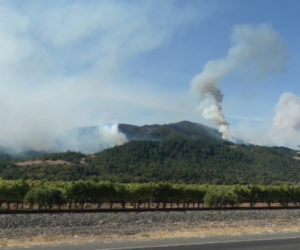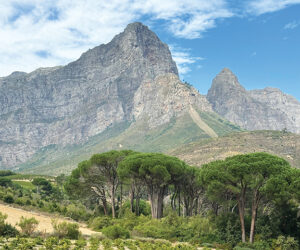In the United States, Australian winegrowers are probably still best known for powerful, quality, fruit-driven Shiraz, the Aussie name for Syrah. According to Wine Australia, about 450,000 tons of Shiraz make it to the crusher each year — roughly the same as California’s annual Cabernet Sauvignon harvest. Equally famous — or infamous — are budget wines from Down Under. These bottlings, brands like Yellow Tail and Lindeman’s, offer very quaffable versions of many grape varieties for as little as five bucks a bottle.
Who’s Complaining, Mate?
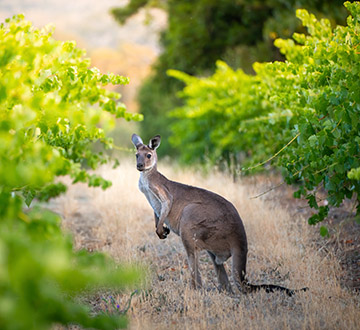
However, to think of Australian wine as classy Shiraz on the one hand and budget vino on the other, is to miss a lot of Aussie wine. During the last 20 years or so a wide range of contrasting wine styles have become more of a focus for Australian winegrowers and won increasing attention from wine lovers around the globe.
Like our brother and sister winegrowers in the United States, recent years have seen the emergence of what’s sometimes described as a more European style of winemaking. There’s greater use of cooler climates for growing grapes, harvesting optimally ripe rather than overripe fruit, more sensitive use of the crusher and press, and less use of new oak. As a result, Aussie wines that were previously overshadowed have come into the light.
In this article we’ll discuss three Aussie wine styles that any budding home winemaker should try and master. I’ve assembled some top winemakers from Down Under to show you how.
For more than 150 years, wines from the Sémillon grapes, grown in the Hunter Valley, have arguably produced Australia’s most distinctive wine. Until Chardonnay became popular here in the 1970s, Sémillon was the white of choice for many Aussies. Those glory days are wittily remembered by some as the B.C. years — Before Chardonnay! Although also a component of French dry white Bordeaux blends and sweet Sauternes dessert wines, many experts say there’s no other wine area able to produce Sémillon like the Hunter Valley. In this region, Sémillons in their youth offer refreshing acidity and delicate, lemony fruit, but when they age — sometimes for decades — the wines develop unique toasty and nutty aromas. Adrian Sparks, Chief Winemaker from Mount Pleasant Winery in the Hunter Valley will explain how he makes his versions.
GSM wine blends have come to the fore in Australia more recently. The acronym, often printed on the bottles, stands for Grenache, Shiraz, and Mourvèdre (this grape also goes by Mataro or Monastrell) and is Australia’s version of the red wines made in France’s Rhône region. It’s the Aussie equivalent of the Rhône-style blend in the United States. Winemaker, Russell Schroder’s GSM has won top accolades from Australia’s most respected wine expert, James Halliday. The Semprevino winemaker, based in McLaren Vale, South Australia, will take us through his winemaking process.
We’d be leaving a gap the size of the Sydney Harbor Bridge if we didn’t look at Shiraz, the most widely planted grape in the country. Thanks to phylloxera — the vine-root eating insect that destroyed most French vineyards towards the end of the 19th century — Australia has the oldest continuously producing Shiraz vines in the world. According to Wine Australia, these ungrafted vines date to the 1840s. The Henschke family’s Shiraz vines are only a couple of decades younger than that. The Henschkes, based at their biodynamic estate in South Australia’s Eden Valley wine region, are one of Australia’s earliest winegrowing families. Fifth generation winemaker, Stephen Henschke, makes a renowned, hard-to-get (many here would say iconic), Shiraz bottling. The 2016 vintage of the Hill of Grace, named after its vineyard, was rated at 99 points by the Halliday Wine Companion (the most comprehensive guide to Australian wines and wineries) and sells for about $700 a bottle.
Let’s jump in!
Sémillon Wines: Australia’s Gift to the World
Mount Pleasant Winery in the Hunter Valley has an impressive history. One of its first winemakers, Maurice O’Shea, who died in 1956, is a cult figure among Aussie wine lovers. He’s thought to be the first winegrower to use temperature-controlled ferments in the region, which he did during the 1920s and without electricity, just blocks of ice dragged in by horse and cart! He was legendary for his tasting and blending abilities and is credited with being one of the first, if not the first, Aussie winemaker to produce consistently world class, age-worthy reds and whites, including Sémillons.
Generations later, O’Shea’s successor at Mount Pleasant is Chief Winemaker Adrian Sparks, an acclaimed winegrower in his own right. He made his first Sémillons more than 20 years ago, but it wasn’t until 2014 that he moved to the Hunter Valley and really appreciated the special conditions there, particularly at a Mount Pleasant vineyard called Lovedale.
“It’s quite a unique spot. Sandy, free-draining soils, producing a light, highly aromatic style of Sémillon for the Hunter,” he says.
Sparks adds that Australian Sémillon is completely unique and, “arguably the only wine style made in Australia that isn’t comparable to anywhere else in the world.” He quotes British wine writer Jancis Robinson who describes it as, “Australia’s gift to the world.”
Sparks adopts a “less is more approach” to winegrowing.
“I try to not let the winemaking hand be shown. It’s all about maintaining the vineyard characters and getting those grapes from vine to bottle in the best condition with the least intervention possible.”
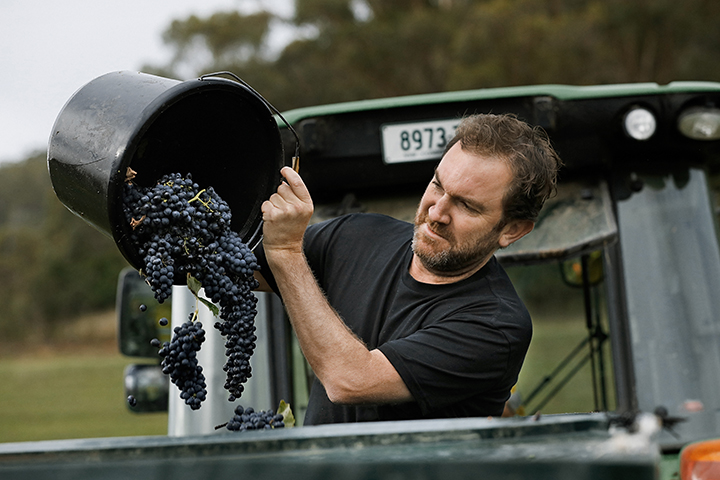
Sparks picks his Sémillon at optimal flavor ripeness, which usually means harvesting at 10.5 to 11 Baumé (18.9 to 19.8 °Brix). This results in very low pH levels of 3.0 to 3.3 and high natural acidity of about 7 to 8 g/L.
“As the grapes ripen, their characters change, moving from greener notes likes beans and herbal characters into citrus and then again into tropical notes. We like to pick as soon as those green characters have all gone and you are left with fresh citrus and get a lemonade taste,” Sparks explains.
Interestingly, he says Mount Pleasant’s older vines tend to have the lower pH. “Our vines planted in 1946 would be picked around 3.0 pH, while the younger material planted in the ‘80s at around 3.2.”
When the Sémillon grapes arrive at the winery they go through a rigorous weighing and sorting process.
“If there have been any grapes picked we aren’t happy with we will remove them, or declassify the whole bin to a lower program. It’s all about having the best fruit available before you start anything,” he says.
Rather than whole bunch press as many winegrowers do, including Sémillon producers, Sparks destems and crushes the grapes right away. The idea behind whole bunch pressing is to preserve delicate fruit flavors and avoid extracting heavier phenolics from the skins. So, Spark’s approach may seem somewhat counterintuitive, ironic, or just genius. He says they crush the fruit to release more free run juice so they don’t need to apply so much pressure in the press.
“We try to extract as much free run juice as we can without rolling the press as this rolling will start to pick up phenolics and we want to minimize this.”
Sparks puts his press on a long, slow cycle with the free run and pressings held separately. The resulting must passes through an over engineered, super powered chiller that can get the fruit down from 25 °C to 2 °C (77 °F to 36 °F) in only one pass.
“This must is air-bag pressed to stainless steel tanks for cold settling,” says Sparks. “After two days, we rack to another stainless steel tank and allow the must to warm naturally before inoculation.”
Spark’s philosophy of minimal intervention and letting the grapes speak for themselves continues with fermentation where a neutral yeast is used. “When the juice is around 14 °C (57 °F) we inoculate with a neutral yeast designed to be a strong fermenter and impart no characters. We have used DV10 over the last 8–9 years, a change from T306 used back in the day.” Both of these yeasts are usually easy to find online, or at your local home winemaking supply store in small 5- to 100-g packets.
The fermentation is kept cool, at 15 °C (59 °F), until the must reaches about 4 Baumé (7 °Brix). This is a good temperature to maintain fresh fruit aromas. “Then we flick the cooling off to allow the ferment to finish out, and once done, we set at 10 °C (50 °F) to get the yeast lees to drop out,” he says.
The fermentation usually takes about 12 days and the low temperature towards the end inhibits a malolactic conversion (MLF), which would be undesirable in a wine renowned for fresh tasting fruit. A malolactic conversion, by changing tart malic acid to buttery lactic, would soften the wine and contribute somewhat creamy aromas.
At this point, I was expecting the Sémillon to be transferred to oak barrels of some kind. After all, where does aged Hunter Sémillon’s renowned toasty aroma come from, if not oak?
“No oak. All pressed to stainless steel. All those toasty notes you see in an aged Hunter Sémillon come directly from the bottle maturation. A lot of people new to Hunter Sémillon always say they see oak in the old wines,” says Sparks.
I’m not exactly new to it, but I feel like I am now. That’s incredible bottle aging! (Although it is true that some Aussie Sémillons do touch oak.)
“So, the bottle does all the maturation and as it ages, it becomes like nothing else, rich and complex and an amazing thing to taste.”
Sparks uses a crossflow filter that he describes as “an extremely effective clarifier.” A small crossflow filter will set you back more than $20,000, well beyond the resources of the home winemaker. For more traditional filtration methods like plate and frame filters, Sparks emphasizes the importance of treating the cellulose pads properly before filtration to ensure the wine’s flavor isn’t tainted by a wet cardboard taste. This means rinsing and conditioning the pads, often by circulating a citric acid solution and then flushing with water.
Sparks does add sulfite, but only after fermentation. He believes lots of small sulfite additions require more movement and exposure of the wine to air, which can lead to oxidation.
“Around 100 ppm of sulfite and usually there may be a small touch-up prior to bottling. We aim for one addition post ferment and generally this works well.”
Sparks also does a heat and cold stabilization to remove proteins and tartrates (wine diamonds) respectively. This is typical for whites to safeguard the wine from cloudiness due to proteins and for stopping tartrates from forming when the wine is stored at cool temperatures.
“To be honest it’s probably more of an aesthetic thing for age-worthy Sém (Sémillon), as people can be put off by slightly cloudy wines or wine diamonds forming,” says Sparks.
The Hunter Valley winemaker advises anyone having their first go at making a Sémillon to “treat it with respect.” He also recommends getting to know your grape source to better appreciate the qualities of the vineyard. “Those unique expressions from the vineyard are so important,” he says.
GSM Blends, UFOs, and Popes
Aussie GSM blends, like Rhône blends in the United States, are red wines made from the same grape varieties used by winegrowers for centuries in France’s Rhône region. There are about 30 varieties there, but Southern Rhône reds are the closest match to versions made by our New World pretenders. These wines traditionally focus on Grenache in combination with Syrah and Mourvèdre, but Cinsault, Terret Noir, and Counoise are regular blend components too.
Both Australian and U.S. winemakers started producing Rhône-inspired blends in the 1980s. The stories of how that happened are pretty odd and need to be told.
California’s Randall Grahm introduced a Rhône blend in 1984 that marked the rise of this blend in America (he retired it in 2019). This creative wine guru named his Syrah, Grenache, and Mourvèdre combination “Le Cigare Volant,” which means “The Flying Cigar.” The name was inspired by an unusual 1954 bylaw in the famous Châteauneuf-du-Pape wine region that prohibits UFOs from landing on vineyards.
Not to be outdone, in Australia the first Rhône blend was developed in 1988. Charles Melton made the wine in South Australia’s Barossa Valley, an area known more for Shiraz. Unlike the U.S., Australia has a long history of planting Grenache (since the 1830s). However, during the 1980s many winemakers were pulling it up because of an oversupply of red grapes. Melton refused to follow this trend and, like Grahm, was inspired by wines made in Châteauneuf-du-Pape. He thought he was directly translating the name of his inspiration when he called his wine Nine Popes. Unfortunately for Melton, the correct translation of Châteauneuf-du-Pape is Pope’s New Castle, not Nine Popes! But the labels were on the bottles and it was too late to change the name. This wine launched the blend Down Under. Melton’s winery still makes one, and they still call it Nine Popes.
Today, GSM blends are a hallmark of the Aussie wine industry. Semprevino Winemaker Russell Schroder’s 2017 McLaren Vale GSM scored 95 points from the 2020 Halliday Wine Companion. Grenache is the dominant variety in Schroder’s version.
“I love Grenache, it’s full of sweet fruity characters but it needs something to carry it along — Shiraz giving palate structure and Mourvèdre adding complexity and savory notes.”
The mechanical engineer-turned-winemaker says he only adds Shiraz and Mourvèdre to complete the wine and aims to maintain what he calls its Grenache signature.
He describes his winemaking style as “old fashioned” and sources fruit from cooler parts of South Australia’s McLaren Vale region where fruit ripens with lower sugar levels.
“I like to preserve fruit characteristics that not only reflect the variety but also the site on which the fruit is grown. I use old French barriques (barrels) for maturation to ensure there is no overpowering oak influence on the nose or palate — fruit characters remain at the forefront.”
He emphasizes the importance of fruit ripeness. “Typically, for Grenache this will mean a Baumé around 14.5 (26.2 °Brix), or maybe higher. You are looking for flavors like strawberries, cherries, and confectionary — think boiled lollies (hard candies). Hopefully a pH around 3.6 and an acidity of 6 g/L tartaric, although this can be challenging in Australia.” Summertime temperatures consistently soar well above 38 °C (100 °F), reducing acidity and boosting sugar levels in the grapes.
He says for the Shiraz and Mourvèdre, a slightly lower Baumé of 14 (25.2 °Brix) is sufficient, as long as there are no green aromas. Grenache and Shiraz are harvested at about the same time. Mourvèdre tends to be two to three weeks behind. Schroder says that, generally speaking, his winemaking process is the same for each variety.
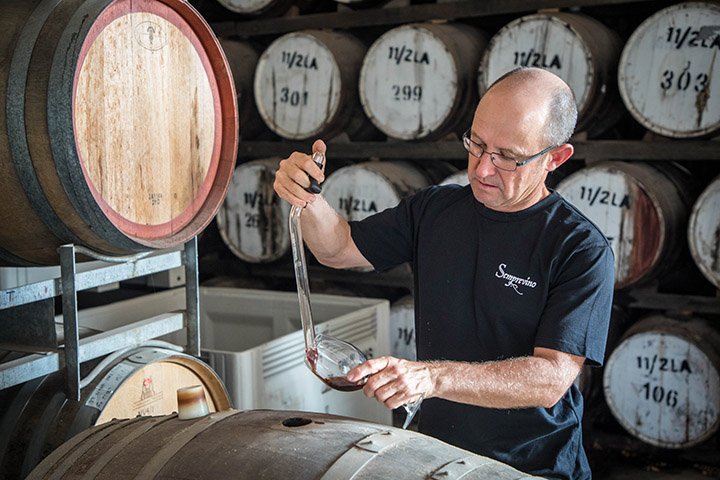
Russell Schroder is the Winemaker at Semprevino in McLaren Vale.
On arrival at the winery the grapes are destemmed, lightly crushed into small, open fermenters, and cooled down via a must chiller to 10 °C (50 °F). He adds 75 grams per tonne (82.7 grams per ton) of sulfite and makes any sugar, pH and acid adjustments.
“I like a two-day cold soak before inoculation. I find it helps to preserve the fruit characters of the grapes.”
Schroder likes Rhône yeasts and often uses Lallemand 2323. According to Lallemand, this yeast is designed for high alcohol production, extraction of phenolic compounds and low volatile acidity. 500-g packets are the norm but local winemaking shops may stock smaller dosages.
“After inoculation I am looking for a gradual rise in temperature, peaking at 32 °C (90 °F), when the Baumé has reached zero (0 °Brix).”
This peak temperature is on the warm side for reds and a good one for extracting color, tannins, and phenolics but many experts — including the Wine Wizard Alison Crowe herself — would recommend caution to make sure you do not let your fermentation get any hotter than this. Ferments above this temperature can reduce aromas, kill the yeast, and produce a cooked or stewed fruit aroma in the wine. To guard against this, Schroder uses cooling plates on the fermenters to manage possible temperature spikes and control the fermentation rate.
During fermentation Schroder does regular pumpovers, depending on the rate of fermentation. This cap management ensures the cap of skins that forms on top of the juice/wine during fermentation is broken up to keep grape solids soaked in wine, extract phenolics, and prevent spoilage. Pumpovers use a hose attached to a pump to circulate the juice/wine from the bottom to the top of a container.
“At the peak of ferment, Baumés of between 10 and 4 (18 and 7.2 °Brix), pumpovers would be four to five times per day.”
An alternative, gentler technique — and probably more accessible for home winemakers without access to an electric pump — is the punchdown. This method is hard, physical labor and involves pushing down the cap by hand using a plunger tool.
Schroder says an 8–10 day ferment is typical, although the wines are usually on their skins for up to 2 weeks in total, depending on taste and palate structure development. Then it’s press time.
“The decision to press is based on flavor and palate structure. I taste ferments morning and night to determine when a wine is ready to press. I think the best advice is to wait until a ferment tastes like wine. Obvious, really,” he says.
Schroder prefers to use a bladder press. “It achieves the same results as a basket press in much less time and you tend to lose less to the hard pressings fraction.” A bladder press (also known as pneumatic membrane or air bag press) can press up to about 20 tons of fruit in one go. The more traditional basket press can only manage about 5 tons at one time.
Press cuts are also made based on taste, taking into account vintage and varietal differences. Schroder says he does sometimes press the Grenache harder than the other two varieties.
“You can extract more from Grenache, given its skin tannins are less aggressive, but you do need to be wary of seed tannins,” he says.
The pressed wines go into stainless steel tanks for settling and a natural malolactic fermentation. During this time, Schroder is tasting the separately fermented Grenache, Shiraz, and Mourvèdre components of his wine and making blending decisions.
“I will always blend my GSM parts prior to barreling down. Amalgamation of the parts will be better over the longest period of time possible,” he says.
Whatever wine you are making, when to blend is a very interesting question. Schroder’s decision to do it early — before barrel aging — is supported by many winemakers. Advocates say the resulting wines are better balanced.
However, plenty of others monitor the evolution of their separate blend components in barrel and then blend. The oenologist Michel Rolland, probably France’s most well-known winemaking consultant, is known to prefer blending once barrel aging of the different varieties or vineyard lots is completed.
A third option, possibly a compromise of the first two, is blending early but holding back press wine to add later. In the end, you get to choose!
After several weeks of settling and preferably completion of MLF, Schroder’s GSM wine is racked to used — often 10-year-old — French barrels for maturing.
During this time, he keeps wines at 90 ppm total SO2. “I like this number as it keeps the wines fresh and microbially stable. At bottling, I am happy with a little less, assuming they have 25 ppm free SO2.”
If MLF hasn’t already completed when the wine is racked to barrels, Schroder adds less sulfite to make sure it happens there.
“I am looking for zero oak characters in my GSM – just a touch of developed aging to add complexity to the wine. Old French barriques is my preference.”
Sourcing French or American barrels can be a real problem for some wineries, but not for Schroder. “Not many modern wineries like to keep their barriques for more than 10 years, usually less, so they are easy to buy.”
In fact, Schroder says the older the oak, the better.
He prefers not to filter. Instead, during barrel maturation he’ll rack the wines three or four times to remove sediment and that usually eliminates any need for filtration.
Schroder doesn’t heat or cold stabilize either.
“I don’t think it is necessary. I have thought about cold stabilization from time-to-time, particularly when a wine is on pour in a bar or restaurant and you know that last glass is going to contain a mouthful of crystals! Cold stabilization messes with the integrity of the wine, so I have held firm.”
He advises the home winemaker who’d like to try making an Aussie-style GSM to source grapes from a quality Grenache vineyard. The older the vines, the better.
“Old vines give flavor intensity and a sense of place to the wines they produce. Grenache is grown widely in the U.S., particularly in California, so finding grapes via a supplier shouldn’t be too hard.
At the blending stage, he says, start with the Grenache foundation, then play around with the Shiraz additions and finally add Mourvèdre. “See how much Mourvèdre the final blend can take — it won’t be a lot!”
Grenache makes up between 60-75% of Schroder’s final blend. The Shiraz usually makes up 20–35% and Mourvèdre 5–10%. He says Aussie GSM’s tend to be in the proportions 70/20/10. However, like U.S. Rhône styles, there are versions that don’t lead with Grenache. For example, there are SGM, MGS, and MSG wines. The letter order in the acronym tells you which grape contributed most to the blend.
Schroder says the resulting wine shouldn’t be too powerful, ready to drink while young and with possible medium-term cellaring potential.
“Others may see it differently, but for me a GSM should be fun,” he adds, in typical, laid-back Aussie style.
Aussie Shiraz: From Ball Busting to Elegant
Australians drink more of their homegrown Shiraz than any other wine. There are bold, fruity, easy-drinking bottlings, but also more complex, structured versions, and, in recent years, more delicate ones are even calling themselves Syrah!
For example, in typical, old school Aussie fashion, the well-named Ball Buster from Tait Winery in the Barossa Valley is a big, flavorful Shiraz (with 16 consecutive 90+ scores from Robert Parker’s The Wine Advocate). There’s also the world famous Penfold’s Grange, a Shiraz-based blend, considered Australia’s iconic red equivalent of a French Château Haut-Brion or a Napa Stags Leap. A new generation of winemakers have also pushed the range of Shiraz styles, developing lighter, arguably more nuanced offerings.
Somewhat elusively, fifth generation winemaker Stephen Henschke says his family’s iconic Shiraz that grows in the Barossa region’s Eden Valley in South Australia, “has greater continentality” than most other Aussie Shiraz. What this means is that in the Eden Valley climactic conditions are less impacted by the moderating influence of the ocean and the altitude of 1,300 to 1,650 feet provides relatively cool temperatures. There’s also a greater temperature differential between day and night, which, Henschke says, maintains acidity, aromatics, and elegance. He says this helps make a Shiraz that displays aromas of spicy, ripe dark fruits, black pepper, crushed herbs, and a layered, textural palate with velvety tannins and a long finish.
The Henschke approach to winegrowing involves very careful attention to organic and biodynamic practices in the vineyard and then handpicking the fruit.
“As caretakers of old-vine shiraz, we use biodynamic compost covered with straw mulch, zero tillage, native grasses and native flowering plants to encourage predatory insects to control pests,” he says.
Harvesting takes place when the grapes have flavors of ripe berry fruits, such as blueberry, blackberry, and dark plum. He says when you chew on the skins and seeds the tannin flavors should be mature and not taste harsh and bitter. Henschke recommends harvesting at a pH of 3.4 or lower (or to adjust to that level in the winery), 13–14 Baumé (23.5–25.2 °Brix), and 6–7 g/L of natural acidity.
“We sort, destem/partial crush, transfer to fermenters and add 20 ppm PMS (potassium metabisulfite).”
The fermenters and containers used can be stainless steel, cement (although only if wax lined), ceramic, or oak barrels. For Shiraz they generally use wax-lined concrete submerged cap fermenters. Henschke says this is in accordance with tradition, thermodynamics, and practicality. “We never use plastic,” he adds, saying that it can contribute off-flavors and contain plasticizers made with contaminants that are a risk to people’s health.
Henschke likes to use a strong neutral fermenter like EC-1118 Champagne yeast. This yeast is readily available to home winemakers in small 5-g sachets.
“We do cool ferments at around, or less than, 24 °C (75 °F). The ferments take 7–10 days.”
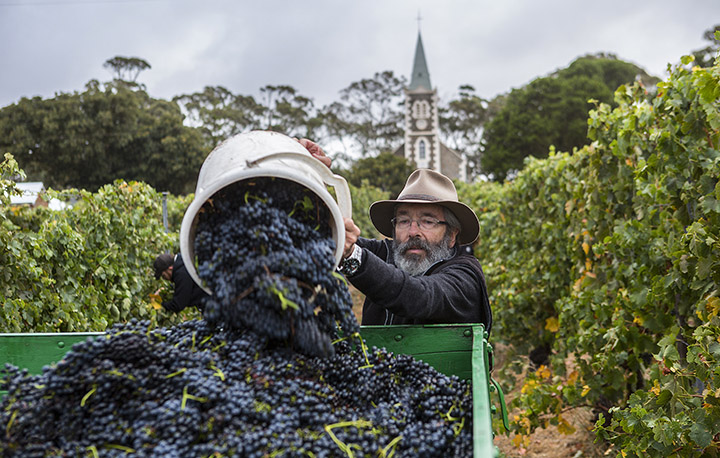
Stephen Henschke is the fifth generation Winemaker at Henschke in South Australia’s Eden Valley.
Many winemakers push their Shiraz fermentations well into the upper 20s °C/lower 80s °F. Henschke’s lower temperature contributes to preserving fresher fruit characters and extends the primary fermentation for more time on the skins and gentle extraction of phenolics.
Henschke uses submerged cap fermentation. Rather than cap management using punchdowns or pumpovers, this technique uses timber heading boards or a stainless mesh screen to trap the skins and other solids in the middle of the tank to keep them in constant contact with the fermenting juice. Henschke prefers submerged cap because he says it is very gentle, minimizes mechanical maceration, and leads to more elegant wines and less extractive chewy tannins.
After primary fermentation they add pure culture malolactic bacteria in a temperature-controlled, stainless steel tank kept to 20 °C (68 °F).
Before sending the wine to press, Henschke tastes for mature tannin, flavor, and structure.
“After a gentle press cycle, we settle overnight in a stainless steel tank. We then transfer the wine to seasoned French or U.S. oak with no more than 20–30% new.”
They only filter if necessary. “A clear wine is essential so a careful and/or gentle filtration can be positive,” says Henschke. “We check the turbidity. If necessary we filter with a 20 micron stainless mesh screen.”
Turbidity is the particulate level in wine, in other words the amount of suspended solids. Yeast, bacteria, and crystalline material are among these particulates. If a wine’s nephelometric turbidity units (NTUs) are less than 1, it is usually regarded as ready to bottle. For the home winemaker without filtration media like a metal mesh, or pads, letting the red wine settle after fermentation and then racking is usually sufficient.
After malolactic conversion Henschke adds around 40 ppm of sulfite.
“It is important to stabilize the free aldehyde and reduce the risk of Brettanomyces or other spoilage yeast and bacteria,” he says.
They don’t bother with a heat or cold stabilization for their Shiraz.
“With reds, neither are important. In saying that, it is easy to hold the reds cold over winter to cold stabilize by default,” he says.
When it comes to barrel aging his Shiraz, Henschke is careful to use correctly seasoned oak, adding that choosing the perfect toast level that complements without overshadowing the wine takes years of trial and error. “Shiraz is one of the few red varieties that shows a strong sense of place. Hence, the vineyard character is much more exciting than an oak forest flavor!”
Henschke’s advice to a budding Aussie Shiraz winegrower? “You are not a winemaker, you are a nurse. Select only the best quality fruit — organic and biodynamically-grown if possible — and treat it gently.”
My wife is a nurse, so I will be trying to channel her if I ever make an Aussie-style Shiraz.
Trying these three wine styles would certainly give you some Aussie winemaking credibility. However, like many other wine-producing countries, there are plenty of other wine styles. When you’ve had a go at a Sémillon, a GSM, and a Shiraz, you could try your hand at a Cabernet-Merlot blend, a Sémillon-Sauvignon Blanc, or a straight Grenache. Good luck, mate!


